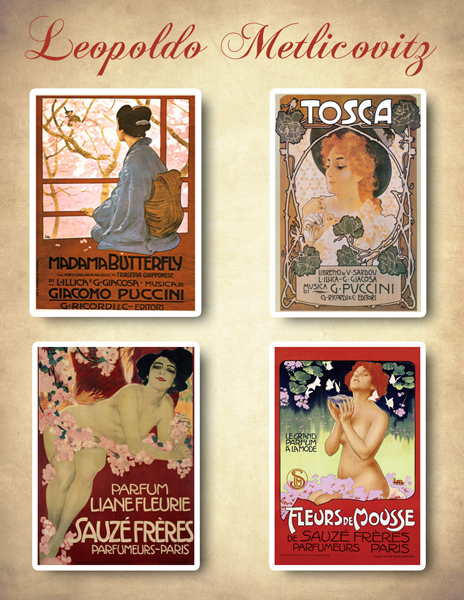Inspiration Can Be Found Anywhere (Part I)
August 10, 2011 Leave a comment
I first encountered Leopoldo Metlicovitz’s posters at a very young age. My grandfather loves music, and more specifically, he loves opera. Throughout his home there are several opera posters of the early 20th century, including two of the four seen the photo below, which are all poster designs by Leopoldo Metlicovitz. Throughout my life I had seen these posters all over my grandfather’s home, and whenever I saw the poster elsewhere it would remind me of my grandfather and his love for opera. I had always enjoyed the top left poster for Madama Butterfly by Giacomo Puccini, because it had certain mystery about it and I also liked the name “Madama Butterfly”.
Last year in school I had to design my own 20th century poster, and for that particular assignment I remembered those posters I was exposed to throughout my life and immediately searched for opera posters for the early 20th century to inspire me. To my surprise, designer Leopoldo Metlicovitz is the creator of some of my favorite opera poster designs. I enjoy the Madama Butterfly poster design because of the use of color and contrast from the inside of the window with dark red tones and the outside of the window which depicts cherry blossom trees with light pink and brown tones and a robin nesting on a tree. I enjoy the contrast of color as well as the placement of the text underneath the seating female figure. The use of light and dark to express the folds on the figure’s clothing is very interesting and it explains how the light from the window is approaching the figure. I particularly enjoy how the painting explains an act of the opera where the female figure, Madama Butterfly, awaits her lover. The rest of Metlicovitz’s designs are similar in color contrast. The artist seems to use dark tones like red for the negative spaces and then lighter pink tones for flowers and lighter skin tones for the female figures. Negative and positive space composition in Metlicovitz’s designs is powerful like the Madama Butterfly window and the Tosca design floral borders.
Much has changed since Leopoldo Metlicovitz painted and designed these posters. It has changed so much that nowadays these poster designs are reproduced in large quantities by the touch of a button. The way we design has changed dramatically because of advanced in technology. In the early 20th century, without computers, artist could replicate artwork yes, but they had to do it by hand. Meaning that one piece of art would not be exactly the same as another even if it were the same artist and design. Technology has made mass production possible; therefore design styles have lost their ‘originality’. For example, the Tosca poster design by Metlicovitz seems symmetrical, but the floral border is not exactly the same on the left as it is on the right. Nowadays, borders like those can be identically symmetrical because of technology and options like ‘reflect object’ in software such as Adobe Illustrator and Photoshop. Design styles have lost their uniqueness and become more ‘stenciled’, where you can see and recognize one simple design element in several design compositions because of the distribution of things such as clipart and stock images. However, the main purposes of a graphic designer’s work still remains to visually impact an audience and clearly represent important information. This can be compared to Leopoldo Metlicovitz work, which is visually captivating, and also clearly states information about the opera or product it is trying to advertise.
I designed the poster below for the class’s assignment, and I was inspired by the posters of Leopoldo Metlicovitz that had been stored somewhere in my memory as a part of my childhood.
I dedicate this post to my grandfather Felipe Ramón Ojeda Russo, whose passion for great music has inspired me all throughout my life, both in my own music studies and appreciation for art.
—
For more design inspiration check out this website.


